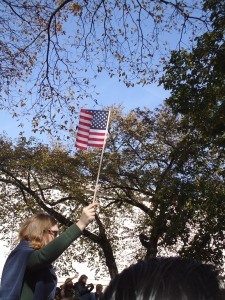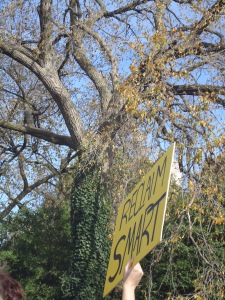By Symi Rom-Rymer
 In the weeks leading up to last Saturday’s Jon Stewart/Stephen Colbert Rally to Restore Sanity and/or Fear, the media world was practically falling over itself trying to analyze, explain, and dissect the event before it even happened. Pundits were asking each other, what it will it mean for the midterm elections, what did it mean about the state of centrist politics, is Jon Stewart preparing for a political campaign, will it draw more crowds than Glenn Beck’s Rally to Restore Honor, and most importantly, will it be a success? Today, having almost fully recovered from being crushed morning ‘til night by 214,000 of my closest friends, I can unequivocally answer, I don’t know, I don’t know, I certainly hope so, and it seems that way. As for the rally’s success, the answer is yes.
In the weeks leading up to last Saturday’s Jon Stewart/Stephen Colbert Rally to Restore Sanity and/or Fear, the media world was practically falling over itself trying to analyze, explain, and dissect the event before it even happened. Pundits were asking each other, what it will it mean for the midterm elections, what did it mean about the state of centrist politics, is Jon Stewart preparing for a political campaign, will it draw more crowds than Glenn Beck’s Rally to Restore Honor, and most importantly, will it be a success? Today, having almost fully recovered from being crushed morning ‘til night by 214,000 of my closest friends, I can unequivocally answer, I don’t know, I don’t know, I certainly hope so, and it seems that way. As for the rally’s success, the answer is yes.
Initially, it was a bit of a letdown. The musical guests, ranging from Cat Stevens to Tony Bennett, while eclectic, didn’t translate well to the crowds. At one point during the performance of gospel singer Mavis Staples and Jeff Tweedy, leader of the band Wilco, the people around me were less excited about the singers than watching someone trying to climb a tree for a better view. And some of the Stewart/Colbert shtick like the “sanity” and “fear” award ceremony or the mock debate between Stewart and Colbert soon lost steam to a mixture of painful silliness of some of the content, the enormity of the crowds, the poor sound, and too few jumbotrons.
And yet what did translate across the Mall, despite the technical difficulties and general goofiness, was the core impetus for the rally: to demonstrate frustration, but sanely. People came from California to Maine to Alaska and willingly stood jammed shoulder to shoulder for three hours, to not just have a few laughs, listen to some nice music and go home. They came to support the idea that despite shouting voices that too often dominate the political and journalistic landscape, there truly is more that brings us together than pushes us apart. This spirit was best exemplified during Father Guido Sarducci’s benediction when he asks God to name his favorite religion and Sarducci’s suggestion that “someone could say to [Jews and Muslims], ‘They don’t eat pork, you don’t eat pork. Let’s build on that” drew the loudest cheers and shouts from the crowd.
 Perhaps some pundits have declared the rally a failure because it did not sufficiently energize the democratic or even centrist base to vote or because it was unclear what the ralliers were rallying for. Indeed, the apolitical nature of the rally was almost shocking given that both Stewart’s and Colbert’s show seem to lean left both in audience and in content. But standing there, in the midst of the crowd, there seemed to be little doubt as to the message that the hosts wanted to impart. This was not a rally to whip people up, but rather to calm them down. In echoes of President Obama’s post-partisan campaign, Stewart, in his closing speech, acknowledged the legitimacy of both the Tea Party-ers and Progressives and separated their rhetoric from those of real bigots. “There are terrorists, and racists, and Stalinists, and theocrats, but those are titles that must be earned! You must have the resume!” he declared. “Not being able to distinguish between real racists and Tea Party-ers, or real bigots and Juan Williams or Rick Sanchez is an insult–not only to those people, but to the racists themselves, who have put in the exhausting effort it takes to hate. “
Perhaps some pundits have declared the rally a failure because it did not sufficiently energize the democratic or even centrist base to vote or because it was unclear what the ralliers were rallying for. Indeed, the apolitical nature of the rally was almost shocking given that both Stewart’s and Colbert’s show seem to lean left both in audience and in content. But standing there, in the midst of the crowd, there seemed to be little doubt as to the message that the hosts wanted to impart. This was not a rally to whip people up, but rather to calm them down. In echoes of President Obama’s post-partisan campaign, Stewart, in his closing speech, acknowledged the legitimacy of both the Tea Party-ers and Progressives and separated their rhetoric from those of real bigots. “There are terrorists, and racists, and Stalinists, and theocrats, but those are titles that must be earned! You must have the resume!” he declared. “Not being able to distinguish between real racists and Tea Party-ers, or real bigots and Juan Williams or Rick Sanchez is an insult–not only to those people, but to the racists themselves, who have put in the exhausting effort it takes to hate. “
 In the wake of the rally, many people are suggesting that Stewart run for office; including Washington Post On Leadership columnist Jena McGregor who wrote that Stewart’s leadership skills outstrip those of real politicians. But we don’t need another politician. What we do need is a 21st century jester who is not afraid to poke fun at the theatrical pompousness of political leaders and media personalities all the while demonstrating a cunning mastery of the issues. We need someone whose job it is not to pander or bloviate, but rather who can effectively take on the aptly dubbed, “24-hour, political pundit perpetual panic conflictinator.” So far, neither political leaders nor media commentators seem up to the task. So we have no choice but to turn to comedians and satirists, as people often do in times of crises, to help us make sense of our situation and offer us the opportunity to laugh at our struggles. And as the throngs on the Mall demonstrate, I am not alone.
In the wake of the rally, many people are suggesting that Stewart run for office; including Washington Post On Leadership columnist Jena McGregor who wrote that Stewart’s leadership skills outstrip those of real politicians. But we don’t need another politician. What we do need is a 21st century jester who is not afraid to poke fun at the theatrical pompousness of political leaders and media personalities all the while demonstrating a cunning mastery of the issues. We need someone whose job it is not to pander or bloviate, but rather who can effectively take on the aptly dubbed, “24-hour, political pundit perpetual panic conflictinator.” So far, neither political leaders nor media commentators seem up to the task. So we have no choice but to turn to comedians and satirists, as people often do in times of crises, to help us make sense of our situation and offer us the opportunity to laugh at our struggles. And as the throngs on the Mall demonstrate, I am not alone.
Symi Rom-Rymer writes and blogs about Jewish and Muslim communities in the US and Europe.

Great article Symi! I do have some few thoughts on the questions of whether the rally fulfilled its objective and/or was a success, as I offer my international perspective:
It was relatively common from the 1950’s to the late 1970’s for Americans to hold protests, rallies, marches, gatherings and whatnot in DC, championing such crucial causes as racial equality and peaceful resolutions to wars and conflicts. At one point, one million people turned up for a march in DC. What does this have to do with now?
Well, the US is currently engaged in two major war fronts and is dealing with a world-wide financial crisis brought on by irrigularities and loosening of credit standards, amongst many other reasons. Official unemployment is 9.6%, but when accounting for people who have given up looking for work and those part-timers (i.e. without benefits, 401K), it’s closer to 20%. One would say that the situation can be compared to the late 60’s when the US was entrenched in Vietnam and the notion of people without jobs were famously called “hippies”.
There is one stark difference between then and now: hippies weren’t as poor as today’s unemployed. They didn’t have credit, let alone the ability to max it out. They may have “borrowed”, but that generally was restricted to the equivalent value of gas money for a VW bus. A lot of today’s unemployed people in the US not only not have money, but they don’t have time, considering everyday adds more interest to their school loans, credit cards, mortgages and car loans. My theory is that this situation has restricted people from voicing their frustrations, from joinging together to be a voice of impacting, long-lasting, positive change.
And just like a lot of things in today’s worldwide economy that is built on advertising; be it either a bunch of frogs advocating a beer, or a duck selling life insurance, the only feasible option is to turn to advertisers to sponsor get-togethers on the US National Mall that have crucial impacts on policymaking, be it the right or left side of an agenda.
So, back to the original two questions. One of the signs I saw a picture of on-line from the rally read, “We should do this more often.” I believe that was the point the Jon Steward and Stephen Colbert wanted to emphasize. It’s not pusing a certain agenda or a cause, but rather restimulating the individual and collective American spirit and thought to go beyond today’s world of consumerism and individual possesions. It is to go beyond tweeting about what restaraunt has the best alfredo pasta sauce to whom hasn’t found a job yet and what a collective group of fellow citizens can do to help. It is to go beyond posting a status update of “Party at Wayne’s 11 PM” to “York, PA still has 34 people in war zones, expecting 5 to return this month.” This may sound utopic, a fantasy. But it’s based on a past America I heard about. A gentleman I worked with in the states, an Italian-American who grew up in Brooklyn, NY, told me of how he remembered,when he was a child, seeing a cloth banner bearing a star, similiar in design, yet larger in shape, to the ones found on the US flag, mounted above the steps of a townhome in his neighborhood, and then it wasn’t long before dozens and then even more homes started raising those banners. Each signified the loss that home endured of a son to the Vietnam war. That’s a community in a conversation about something impactfull to all.
We have a world of connectivity unimagined 40 years ago, but funny how the old times seemed to have people in more conversation about what’s really important than today’s world is able to.
Bringing 230,000 people from all across to the country to be with each other to discuss what’s really important is a success. “Stay focused on the important people and things in life, stay in communication” is the message I came away with.